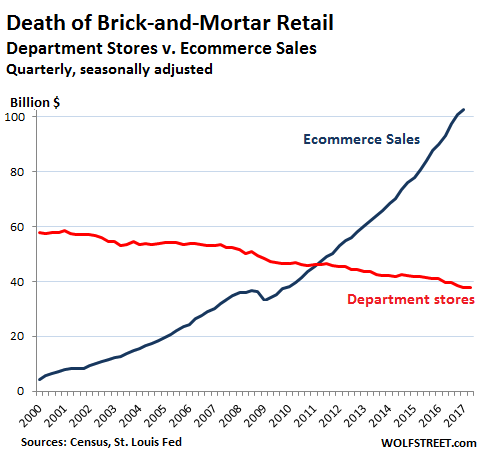The Daily Escape:

Cougar with Radio Collar – Griffith Park, Los Angeles, via Nature Photography
Retailers are closing thousands of stores and going bankrupt at a rate not seen since the Great Recession, and tens of thousands of people are losing their jobs as a result. Although thanks to insolvency experts like Bankruptcy Calgary operated by Hudson & Company, solutions are available to help individuals struggling with debt, the atmosphere for retailers seems far more bleak.
Retailers blame Amazon and other online vendors for the lack of physical sales nowadays. This could be true as more and more people do seem to find it easier to order online than physically enter a store to purchase a product. With e-commerce sales booming, more businesses seem to be offering online products. These e-commerce sites can use recurring billing, if they please, to increase their sales. This works by turning customers who would only purchase something once into customers who are regularly making a payment. However, one reason that many businesses seem to succeed is due to software, like samcart, offering their customers a hassle-free checkout. This means that the whole process of ordering online is becoming so much easier for the consumer that it’s not surprising that retail stores are beginning to feel the effects.
While some brick-and-mortar retailers are doing well, many are losing money. The Atlantic reports that:
Overall retail employment has fallen every month this year. Department stores, including Macy’s and JC Penney, have shed nearly 100,000 jobs since October-more than the total number of coal miners or steel workers currently employed in the US.
Wolf Richter has the following chart showing the nature of the problem for retail stores:

But the e-commerce industry won’t rescue out-of-work retail employees. Most warehouses are regional, and located far from residential areas, which means they might not be within a reasonable commuting distance for displaced workers. By contrast, retail stores are typically located near residential centers. E-commerce warehouses also employ fewer people than retail stores, since the warehouses are increasingly automated, and no longer need to buy roll cages from PHS Teacrate or other companies due to not needing stock delivered to smaller stores.
Yves Smith offers this idea: (parenthesis by the Wrongologist)
One of the reason so many real world retailers are hitting the wall so hard is that private equity leverage and asset stripping made them particularly vulnerable. While the losses to online retailers would have forced some downsizing regardless, the fact that so many are making desperate moves in parallel is in large measure due to the fact that…their private equity (PE) overlords have made them fragile.
That’s a new angle for evaluating Amazon’s performance: it’s not that retailers are closing because Amazon is expanding, but Amazon is expanding because retailers are closing. Jeff Bezos should be thanking the PE firms for looting the retail industry.
The Federal Reserve’s low interest rates also made it easier for Private Equity funds to load these retailers up with debt. Management could borrow more money than necessary, pay themselves cash bonuses, and claim “interest rates are low; making payments will be easy“.
They would even show you the math. Of course, that math assumed that store sales would continue climbing in the future. If sales fell, high debt payments could quickly become an outsized burden.
The Private Equity all-stars often follow a particular deal model. After purchasing the retail company, the PE firm sells the real estate owned by the retail company to another entity (owned by the PE fund). Then the retail company makes lease payments to its new landlord. This splitting of the assets into an operating company and a property company allows the PE fund manager to make a cash distribution to its investors early on, producing a quick return on the deal. Later, the property company will be sold.
The problem with this approach is that businesses that choose to own their real estate are typically seasonal businesses, as all retailers are. Or they are low margin businesses particularly vulnerable to the business cycle, like restaurants. Owning their property reduced their fixed costs, making them better able to ride out bad times.
To make this picture worse, the PE firms often “sell” the real estate to itself at an inflated price, which justifies saddling the operating business with high lease payments, making the financial risk in the operating company even higher. Of course, those high rents make the property company look more valuable to prospective investors, who may fail to look close enough at the retailer who is paying the rents.
Companies with little debt generally can survive lower sales. They can engage in cost-cutting, maybe encourage some employees to retire early, etc. It’s easier to survive if they own their own property. But when you’ve got a lot of debt, and servicing that debt requires that sales continue to rise quarter after quarter without fail, then things become a LOT more fragile.
Trump claims he’s created 500,000 new jobs in his first 100 days. Notice that he doesn’t say what these jobs are, or where they were created. Certainly they weren’t in Retail. Or Coal. Or Steel. Those jobs aren’t coming back.
Here is Jonathan Richman with his 1990 song “Corner Store” which laments what towns have lost to the malls:
Those who read the Wrongologist in email can view the video here.
Takeaway Lyric:
Well, I walked past just yesterday
And I couldn’t bear that new mall no more
I can’t expect you all to see it my way
But you may not know what was there before
And I want them to put back my old corner store.

So sad.